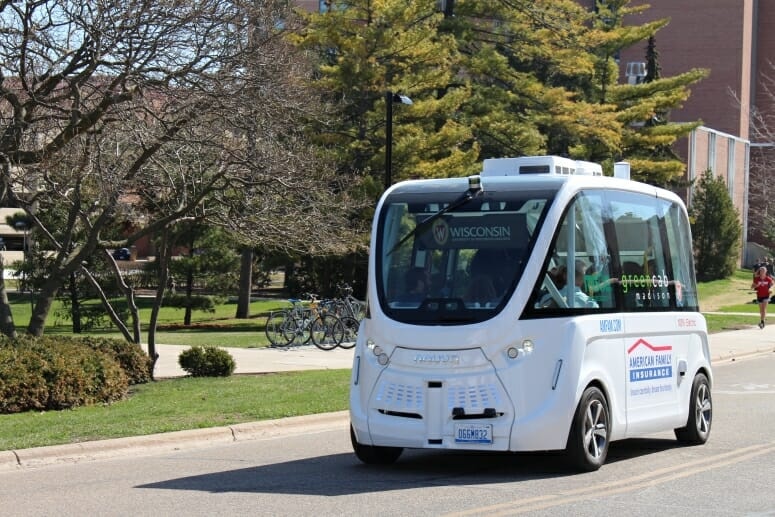May 4 2018
Autonomous vehicles do not text or fall asleep, and are incapable of getting road rage. Driverless cars therefore, look promising as a futuristic mode of transport.
 The Autonom Shuttle, an 11-seat autonomous vehicle made by the French company Navya, gave passengers a tour of parts of campus. (Image credit: Renee Meiller)
The Autonom Shuttle, an 11-seat autonomous vehicle made by the French company Navya, gave passengers a tour of parts of campus. (Image credit: Renee Meiller)
People at the University of Wisconsin-Madison campus got a glimpse of the future on April 24 and 25, 2018 - when the French company Navya’s Autonom Shuttle, an 11-seat self-driving vehicle, picked up inquisitive commuters outside of Russell Laboratories and took them for a short ride covering parts of Elm, Linden, Babcock, and Observatory drives.
This vehicle is driven by technology and a team of people constantly endeavoring to enhance it.
“A lot of people are skeptical, which is good,” states Peter Rafferty, a program manager at UW–Madison’s Traffic Operations and Safety Laboratory. “We’re not here to sell it, we’re here to ask the right questions.”
The federally designated Wisconsin Automated Vehicle Proving Grounds collaboration (WiscAV) is led by the UW–Madison College of Engineering. Rafferty and researchers at the TOPS Laboratory are facilitating autonomous and connected vehicle research through projects, including the collaboration with the City of Madison to test connected vehicle technology on South Park Street. In addition, the laboratory has a full-scale driving simulator.
Two years back, Rafferty took his first driverless ride at a conference.
“I had the luxury of knowing the technology,” stated Rafferty. “On one hand, I came away more confident but I also saw that additional work needs to be done.”
According to the U.S. Department of Transportation, human error is responsible for over 90% of traffic deaths.
“The motivation for us as engineers is all the safety benefits,” stated Rafferty.
The vehicle possesses eight lidar sensors, which enables the detection of obstacles and recognizing things, for instance, knowing the location of the curb. The function of Lidar is similar to that of radar—but it emits pulses of infrared light in place of radio waves and measures the time taken to return after striking nearby objects. At present, it is not built to deal with snow and ice.
Since the vehicle is completely electric, the ride is noiseless. There are 70 Navya shuttles around the world.
Aaron Foster, a sales manager with Navya, who attended the drive, was posed with questions like what would happen in case someone ran in front of the vehicle, which was shortly answered when it stopped and also sounded the horn—gently, but firmly.
Foster explained that geotags in the vehicle help know the position of the stop signs. People at a bus stop were slightly confused and smiled on seeing the Autonom open its doors, after stopping.
“It’s all part of the education,” stated Foster. “We hope the functions continue to progress as time goes on.”
Jennifer Riehl, a postdoctoral fellow in the entomology department, was the passenger of the five-minute driverless trip on Tuesday. As her husband Jonathan Riel was an employee in the College of Engineering, she already knew of the vehicle.
“I’ve been telling everyone about it,” Riehl remarked. “I can see that this would be a cool thing that would be useful for shorter trips.”
She persuaded Allyson Richins, a technician in the entomology department, to come along with her on a ride.
“It’s very impressive,” noted Richins, recounting how the vehicle stopped for a woman to cross the street. “The sensors are strong.”
Computer engineering sophomores, Justin Knapp and Hunter Celeste, had been enthusiastic about driverless vehicles for a while. Both don’t enjoy driving on campus very much.
“It would help to have another form of transportation on campus,” stated Knapp. “The bus is not always convenient and there are tons of stops. Having this would be a lot nicer.”
The vehicle, capable of attaining speeds of 28 miles per hour, moved at about 15 miles per hour during its campus tour.
“I felt like I could walk faster,” commented Knapp.
Of course, safety is paramount, which was also the reason behind a fairly slow and careful ride, something a manually driven car did not welcome as it honked at the slow-moving Autonom at the stop sign. The Autonom was unperturbed.
“I think it can definitely be something for the future as it gets more prevalent,” stated Celeste.
Rafferty believes that while it is going to take some time for driverless cars to take over, they will be slowly incorporated into the transportation landscape. Then, what about the promised flying cars?.
“Those are coming too,” assured Rafferty.
At present, passenger drones are flying above Dubai. Rafferty takes pleasure in reminding people of the fact that the 1962 cartoon “The Jetsons” portrayed a futuristic world in 2062.
“That’s only 44 years from now,” Rafferty remarked. “Things are moving very, very fast.”